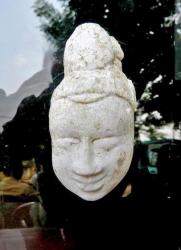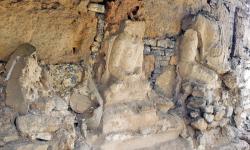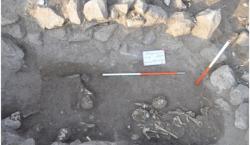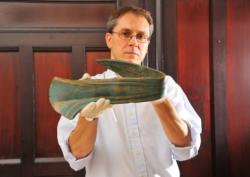INSTITUT SUPERIEUR D'ANTHROPOLOGIE
INSTITUTE OF ANTHROPOLOGY
ONLINE COURSES / COURS A DISTANCE
WINTER TERM : JANUARY 2015
REGISTER NOW
INDE –  Ghantasala - A smiling Buddha idol made of Dachepalli limestone was unearthed from an agricultural field falling under Penneramma mound, a Buddhist site, at Ghantasala village in Krishna district. The idol, six inches in height and four inches width, was found by a local farmer while he was preparing land within the range of the mound, which witnessed flourishing Hinayana sect of Buddhism during the 2nd A.D and 3rd A.D. Period. A team of Indian National Trust for Art and Cultural Heritage, Machilipatnam Chapter led by its Convener T. Ram Mohan Rao and revenue officials on Saturday documented the details of the idol. “The idol is arguably belonging to the period of 6 A.D. or 7th A.D. period, when Buddhism was its peak state on the East Coast. It is rare to see smiling Buddha made of Dathepalli limestone”, said Historian Mohammed Silar. According to excavations by Alaxendar Rea and others in late 1880s, Penneramma mound was one of the mounds of the Buddhism in and around Ghantasala. Other mounds where several Buddhist remains were unearthed earlier are Ernimpadu, Ghotakam Malapalli area and Museum site.
Ghantasala - A smiling Buddha idol made of Dachepalli limestone was unearthed from an agricultural field falling under Penneramma mound, a Buddhist site, at Ghantasala village in Krishna district. The idol, six inches in height and four inches width, was found by a local farmer while he was preparing land within the range of the mound, which witnessed flourishing Hinayana sect of Buddhism during the 2nd A.D and 3rd A.D. Period. A team of Indian National Trust for Art and Cultural Heritage, Machilipatnam Chapter led by its Convener T. Ram Mohan Rao and revenue officials on Saturday documented the details of the idol. “The idol is arguably belonging to the period of 6 A.D. or 7th A.D. period, when Buddhism was its peak state on the East Coast. It is rare to see smiling Buddha made of Dathepalli limestone”, said Historian Mohammed Silar. According to excavations by Alaxendar Rea and others in late 1880s, Penneramma mound was one of the mounds of the Buddhism in and around Ghantasala. Other mounds where several Buddhist remains were unearthed earlier are Ernimpadu, Ghotakam Malapalli area and Museum site.
http://www.thehindu.com/news/cities/Vijayawada/smiling-buddha-idol-unearthed-at-ghantasala/article6626972.ece?utm_source=RSS_Feed&utm_medium=RSS&utm_campaign=RSS_Syndication
GRECE – Amphipolis - Paintings of daily life have been discovered on columns at Greece's biggest ancient tomb at Amphipolis in the northern region of Macedonia, the Greek culture ministry said Saturday. "After cleaning the columns, images of people, objects and utensils were uncovered," Culture Minister Kostas Tassoulas said at a press briefing on the discovery at the site. The paintings may help solve the mystery of who is buried at the highly-decorated tomb from the time of Alexander the Great. A skeleton was found at the site earlier this month.
http://artdaily.com/news/74523/Paintings-discovered-at-the-highly-decorated-tomb-from-the-time-of-Alexander-the-Great?#.VHHUAouG-pA
PAKISTAN –  Taxila valley -Scores of stucco sculptures dating back to the 4th and 5th centuries A.D. are crumbling at the Mohra Moradu Stupa and Monastery due to the lack of maintenance. The monastery has its own significance and importance in the archaeological history of Pakistan as it is among three of the 18 Buddhist sites of the Taxila valley with the intact stucco sculptures and figures of Buddha. The monastery flourished as a beacon of knowledge from 4th to 5th centuries A.D. It is located in a small valley between Sirkap called the second city of ancient Taxila valley civilisation and Jaulian, known as the ancient Taxila Buddhist University. Because of its importance, Unesco included the monastery in its list of the world cultural heritage sites in 1980. But the officials of the Punjab archaeology and museums department have failed to ensure proper maintenance of the sheds erected to protect the stucco sculptures from climatic agents, especially rain. During a visit to the site, it was observed that sheds over the ancient stupa and cells were damaged and rainwater entered the cells and damaged around 80 per cent of the sculptures and figures. The rainwater had also dissolved parts of stucco sculptures and figures of the Buddha. A caretaker at the monastery said he had informed authorities about the poor condition of the sheds but no action had been taken as yet.
Taxila valley -Scores of stucco sculptures dating back to the 4th and 5th centuries A.D. are crumbling at the Mohra Moradu Stupa and Monastery due to the lack of maintenance. The monastery has its own significance and importance in the archaeological history of Pakistan as it is among three of the 18 Buddhist sites of the Taxila valley with the intact stucco sculptures and figures of Buddha. The monastery flourished as a beacon of knowledge from 4th to 5th centuries A.D. It is located in a small valley between Sirkap called the second city of ancient Taxila valley civilisation and Jaulian, known as the ancient Taxila Buddhist University. Because of its importance, Unesco included the monastery in its list of the world cultural heritage sites in 1980. But the officials of the Punjab archaeology and museums department have failed to ensure proper maintenance of the sheds erected to protect the stucco sculptures from climatic agents, especially rain. During a visit to the site, it was observed that sheds over the ancient stupa and cells were damaged and rainwater entered the cells and damaged around 80 per cent of the sculptures and figures. The rainwater had also dissolved parts of stucco sculptures and figures of the Buddha. A caretaker at the monastery said he had informed authorities about the poor condition of the sheds but no action had been taken as yet.
http://www.dawn.com/news/1146132/ancient-sculptures-crumbling-due-to-lack-of-attention
CHINE – 
 Chengdu- Photos taken on November 19, 2014 shows the excavation site of ruins of Tang and Song dynasties near Chunxi Road in Chengdu, Sichuan province. Authorities of the Chengdu Municipal Institute of Cultural Relics and Archaeology said ancient houses, roads, and drainage channels were found in the ruins which was believed to be a former commercial district. [Photo/China News Service]
Chengdu- Photos taken on November 19, 2014 shows the excavation site of ruins of Tang and Song dynasties near Chunxi Road in Chengdu, Sichuan province. Authorities of the Chengdu Municipal Institute of Cultural Relics and Archaeology said ancient houses, roads, and drainage channels were found in the ruins which was believed to be a former commercial district. [Photo/China News Service]
http://www.china.org.cn/arts/2014-11/21/content_34116443.htm?
IRAN –  Ghizilghiyeh - Iranian archeologists have discovered multi-story graves in Ghizilghiyeh Cemetery which belong to the Iron Age, in Meshkinshahr in Northwestern Iran. Head of the archeologists Karim Hajizadeh said there have been 11 multi-story graves in the cemetery in which ancient things including fictile utensils, bayonets, bronze daggers and gray crockery were found, the Iranian students' news agency reported. Other discovered things include stone arrows, decorative beads and golden sequins. Skeletons belongings to dozens of people were found in the cemetery as well.
Ghizilghiyeh - Iranian archeologists have discovered multi-story graves in Ghizilghiyeh Cemetery which belong to the Iron Age, in Meshkinshahr in Northwestern Iran. Head of the archeologists Karim Hajizadeh said there have been 11 multi-story graves in the cemetery in which ancient things including fictile utensils, bayonets, bronze daggers and gray crockery were found, the Iranian students' news agency reported. Other discovered things include stone arrows, decorative beads and golden sequins. Skeletons belongings to dozens of people were found in the cemetery as well.
http://english.farsnews.com/newstext.aspx?nn=13930901001362
ROYAUME UNI –  Norfolk - A spectacular new Norfolk treasure has been unveiled - after years of being used as a doorstop. The 3,500-year-old Rudham Dirk, a ceremonial Middle Bronze Age dagger, was first ploughed up near East Rudham more than a decade ago. But the landowner didn’t realise what it was and was using it to prop open his office door. And the bronze treasure even came close to being thrown in a skip, but luckily archaeologists identified it in time. The dirk - a kind of dagger - was never meant to be used as a weapon and was deliberately bent when it was made as an offering to the gods. Only five others like it have ever been found in Europe - including one at Oxborough in 1988, which is now in the British Museum. The 1.9kg (4lb) dirk is made from bronze, which is nine-tenths copper and one-tenth tin. The nearest source for the copper is Wales, while the tin may have come from Cornwall. Straightened out, it would be 68cm long, slightly shorter than the Oxborough example. It may even have been made in the same workshop, maybe even by the same craftsperson.
Norfolk - A spectacular new Norfolk treasure has been unveiled - after years of being used as a doorstop. The 3,500-year-old Rudham Dirk, a ceremonial Middle Bronze Age dagger, was first ploughed up near East Rudham more than a decade ago. But the landowner didn’t realise what it was and was using it to prop open his office door. And the bronze treasure even came close to being thrown in a skip, but luckily archaeologists identified it in time. The dirk - a kind of dagger - was never meant to be used as a weapon and was deliberately bent when it was made as an offering to the gods. Only five others like it have ever been found in Europe - including one at Oxborough in 1988, which is now in the British Museum. The 1.9kg (4lb) dirk is made from bronze, which is nine-tenths copper and one-tenth tin. The nearest source for the copper is Wales, while the tin may have come from Cornwall. Straightened out, it would be 68cm long, slightly shorter than the Oxborough example. It may even have been made in the same workshop, maybe even by the same craftsperson.
http://www.edp24.co.uk/norfolk-life/archaeologists_hail_incredible_norfolk_bronze_age_discovery_1_3857540